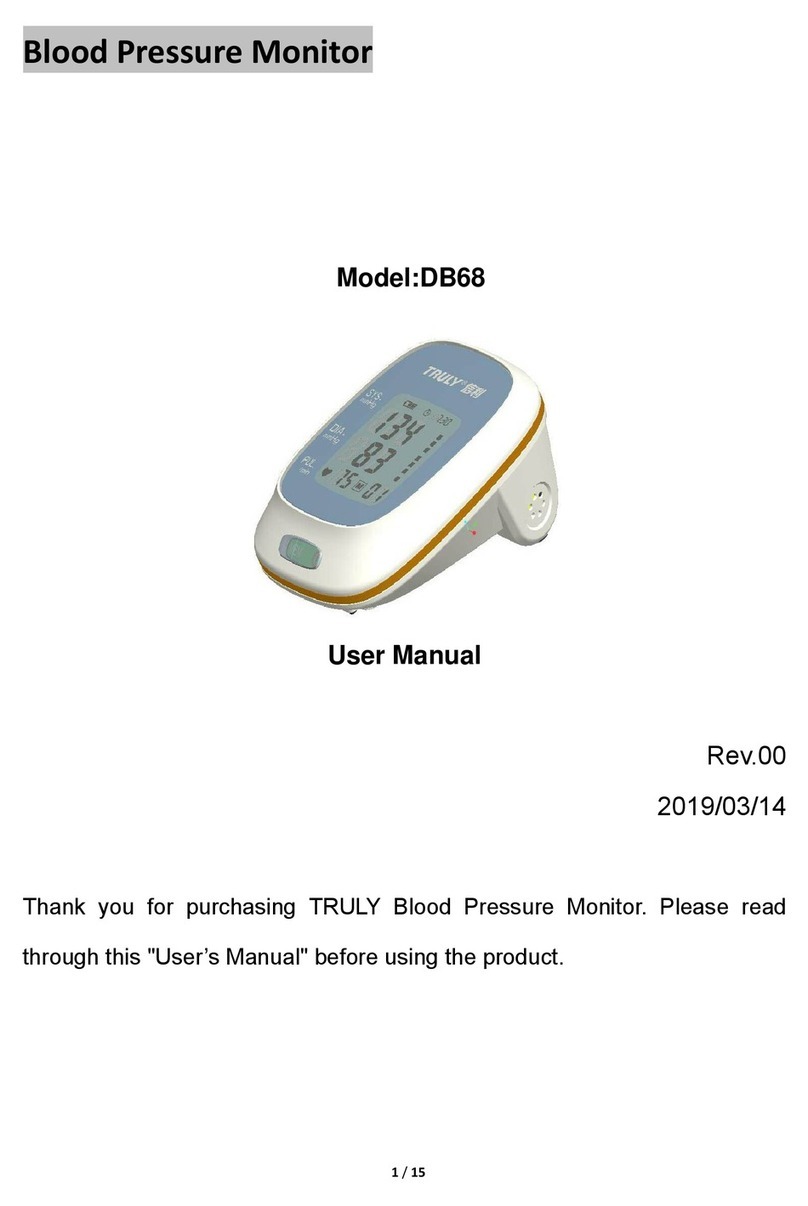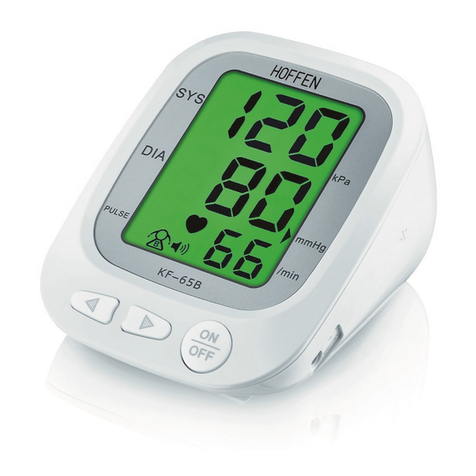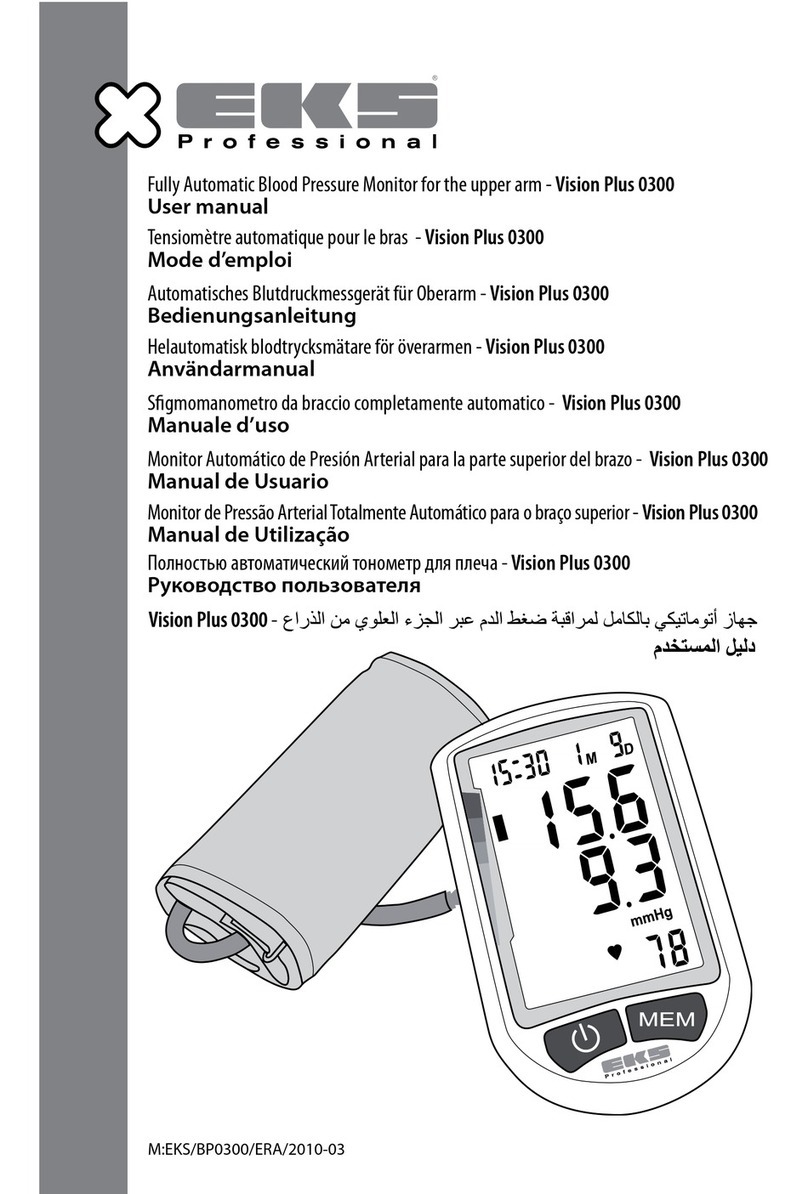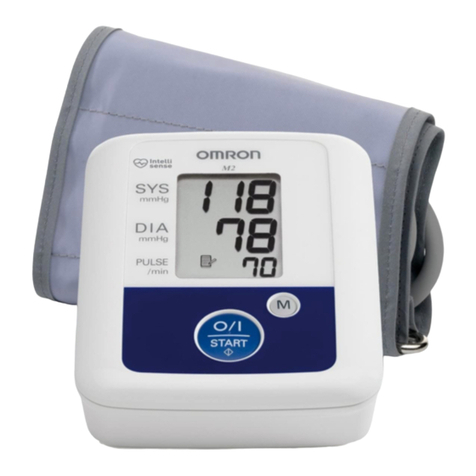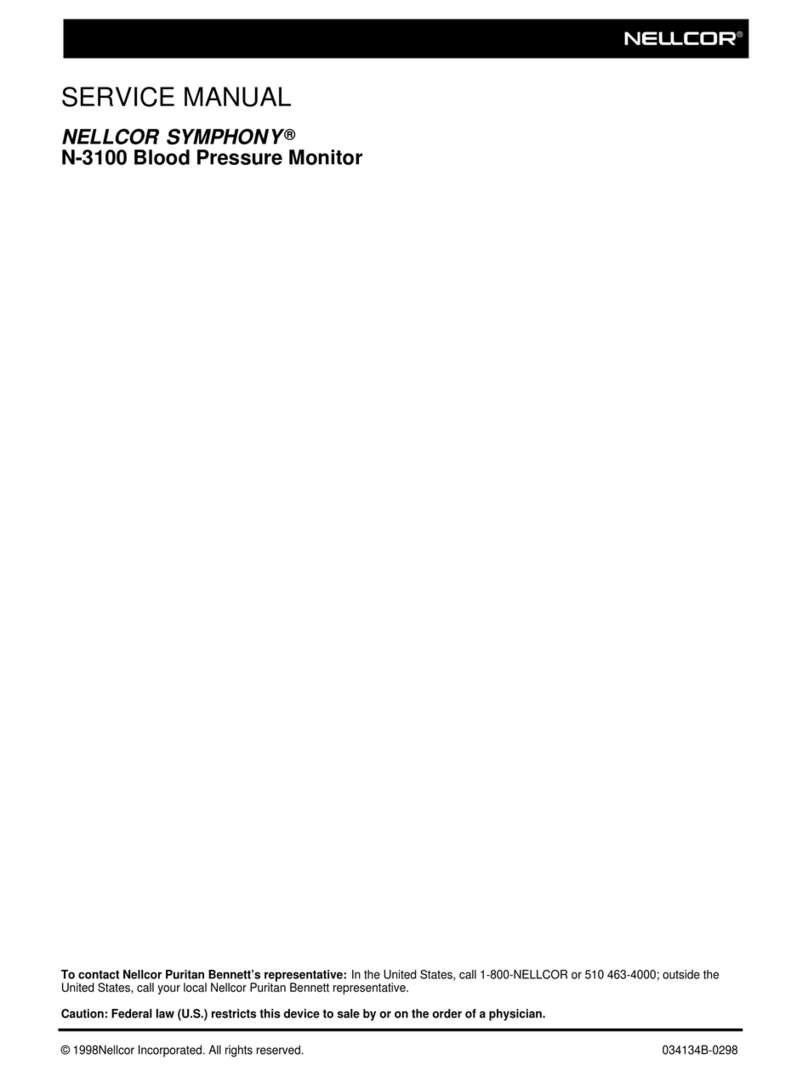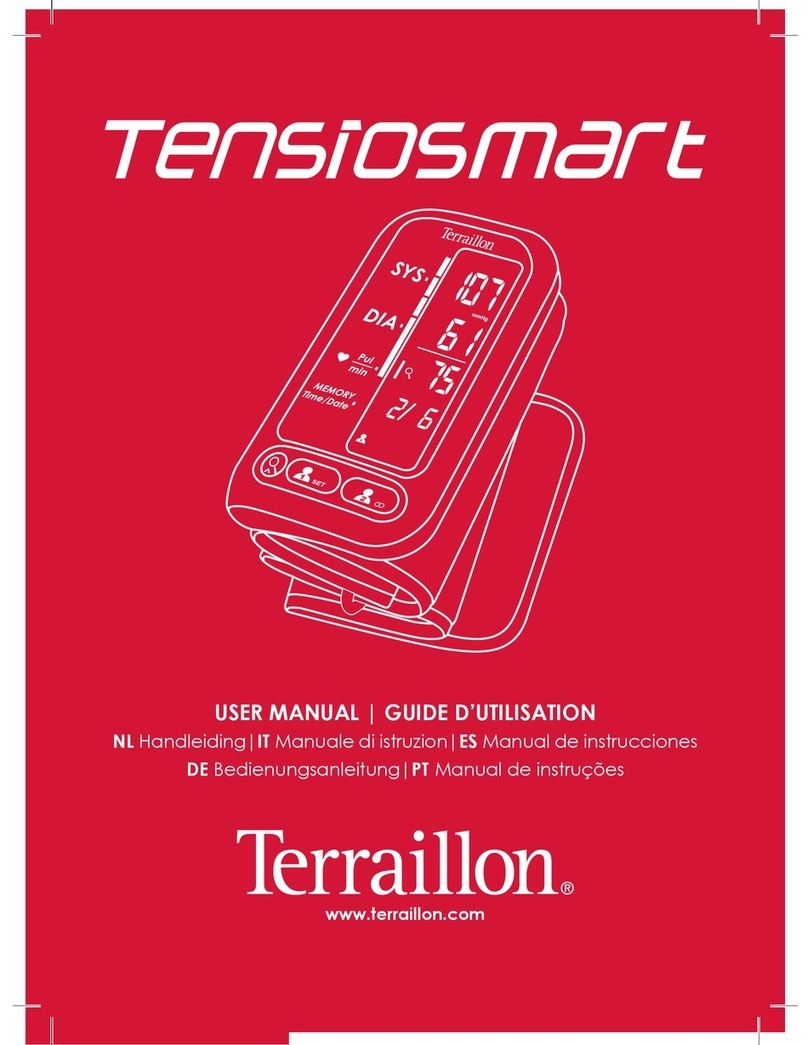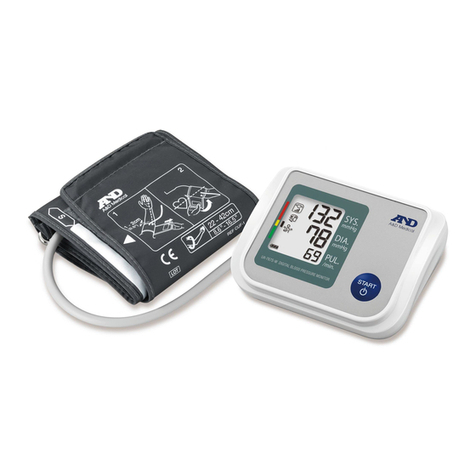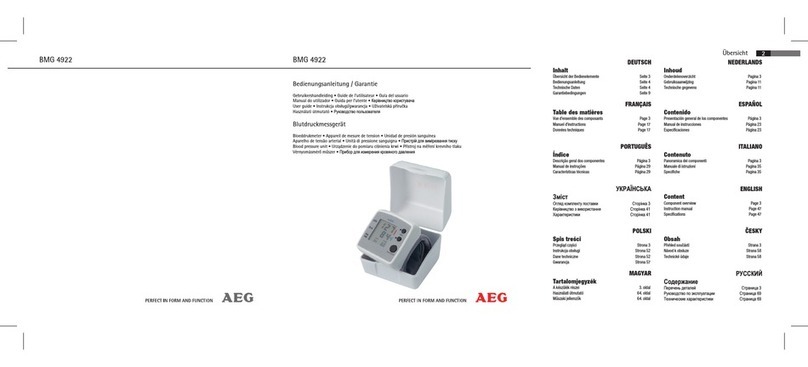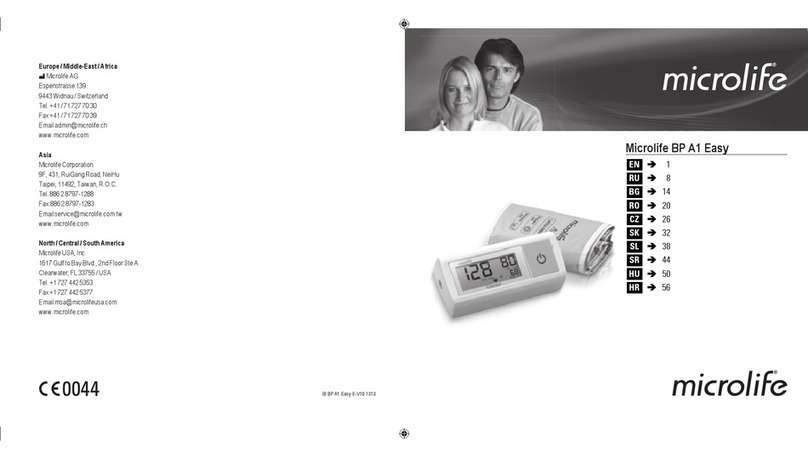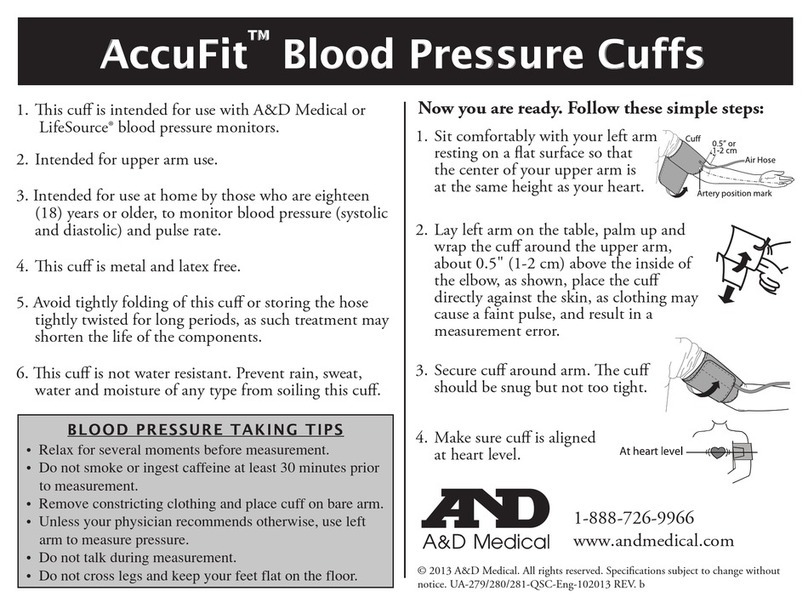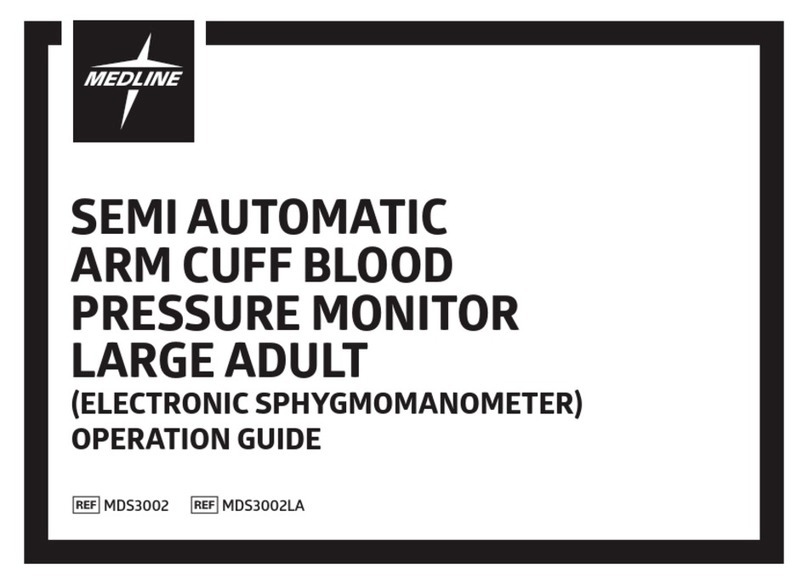trendmedic Viatom Armfit User manual

Automatic Upper Arm
Blood Pressure Monitor
User Manual
English|Deutsche|Italiano|Español|Français
Model Viatom Armfit &
Armfit Plus

Contents
User Manual…….…............…...........English 1-20
Benutzerhandbuch...........….............Deutsch 21-45
Manuale d'uso........…..…....…..........Italiano 46-68
Manual de usuario…………...............Español 69-91
Manuel de l'utilisateu.........…...........Français 92-114

1
User Manual
Contents
1. The Basics................................................................. 3
1.1 Safety.............................................................. 3
2. Introduction ............................................................. 8
2.1 Intended Use .................................................. 8
2.2 Contraindications ........................................... 9
2.3 About the Product.......................................... 9
2.4 Unpacking....................................................... 7
2.5 Symbols ........................................................ 11
3. Using the Monitor .................................................. 13
3.1 Charging the Battery .................................... 13
3.2 Blood Pressure Measurements .................... 13
3.3 Recording ECG.............................................. 16

2
3.4 Reviewing History Records........................... 19
3.5 Connecting with the App.............................. 20
4. Troubleshooting ..................................................... 21
5. Maintenance .......................................................... 22
5.1 Maintenance ................................................ 22
5.2 Cleaning........................................................ 23
5.3 Storage ......................................................... 23
6. Specifications ......................................................... 24
7. Electromagnetic Compatibility............................... 26

3
1. The Basics
This manual contains the instructions necessary to
operate the product safely and in accordance with its
function and intended use. Observing this manual is a
prerequisite for proper product performance and
correct operations, which ensures patient and
operator safety.
1.1 Safety
Warnings and Tips
⚫Before using the device, please ensure that you have
read this manual thoroughly and fully understand the
corresponding precautions and risks.
⚫This device has been designed for practical use but is
not a substitute for visiting the doctor.
⚫The data and results displayed on the device are for
reference only and cannot be directly used for
diagnostic interpretation or treatment.
⚫We recommend not using this device if you have a
pacemaker or other implanted devices. Follow your
doctor’s advice, if applicable.
⚫Do not use this device with a defibrillator.
⚫Do not use this device during an MRI exam.
⚫Do not use the device in a combustible environment

4
(i.e., oxygen-enriched environment).
⚫Never submerge the device in water or other liquids.
Do not clean the device with acetone or other volatile
solutions.
⚫Do not drop this device or subject it to strong impacts.

5
⚫Do not place this device in pressure vessels or gas
⚫sterilization devices.
⚫Do not dismantle the device because this could cause
damage or malfunctions or impede device operations.
⚫This device is not intended for use by people (including
children) with restricted physical, sensory, or mental
acumen or a lack of experience and/or a lack of
knowledge unless they are supervised by someone
responsible for their safety, or they receive instructions
from this person on how to use the device. Children
should be supervised around the device to ensure they
do not play with it.
⚫Do not allow the electrodes to come into contact with
other conductive parts (including the ground).
⚫Do not use the device on anyone with sensitive skin or
allergies.
⚫Do not store the device in the following locations:
locations in which the device is exposed to direct
sunlight, high temperatures or levels of moisture, or
heavy contamination; locations near sources of water
or fire; or locations that are subject to strong
electromagnetic influences.
⚫Do not swing the device with the strap, which may
result in injury.
⚫This device displays changes in heart beat, blood
oxygenation, etc. which may have varying causes.

6
These may be harmless, but may also be triggered by
illnesses or diseases of differing degrees of severity.
Please consult a medical specialist if you believe you
may have an illness or disease.
⚫Vital sign measurements, such as those taken with this
device, cannot identify all diseases. Regardless of the
measurements taken using this device, you should
consult your doctor immediately if you experience
symptoms that could indicate a serious disease.
⚫Do not self-diagnose or self-medicate based on this
device without consulting your doctor. In particular, do
not start taking any new medication or change the type
and/or dosage of any existing medication without prior
approval.
⚫This device is not a substitute for a medical
examination for your heart or other organ functions, or
for medical electrocardiogram recordings, which
require more complex measurements.
⚫It is not possible to use this device to diagnose illnesses
or diseases. This is exclusively the responsibility of your
doctor.
⚫We recommend that you record the ECG curves and
other measurements and provide them to your doctor
if required.
⚫Clean the device and cuffs with a dry, soft cloth or a
cloth moistened with water and a neutral detergent.
Never use alcohol, benzene, thinners, or other harsh

7
chemicals to clean the device or cuffs.
⚫Avoid tightly folding the cuffs or wrapping the hoses for
long periods, to avoid shortening the component use
period.
⚫The device and cuffs are not water-resistant. Keep rain,
sweat and water from getting on the device and cuffs.
⚫Measurements may be distorted if the device is used
close to televisions, microwave ovens, mobiles phones,
X-rays, or other devices with strong electrical fields.
⚫Do not modify the device. It may cause damage to the
device.
⚫To measure blood pressure, the arm must be squeezed
by the cuff hard enough to temporarily stop blood flow
through the artery. This may cause pain, numbness, or
a temporary red mark on the arm. This condition will
appear especially when measurements are repeatedly
taken. Any pain, numbness, or red marks will disappear
with time.
⚫Do not apply the cuff on an arm with another
electronic medical device. The equipment may not
function properly.
⚫People who have a severe circulatory deficiency in their
arm must consult a doctor before using the device, to
avoid medical problems.
⚫Do not self-diagnose the measurement results and
start treatment on your own. Always consult your

8
doctor to evaluate the results and subsequent
treatment.
⚫Do not apply the cuff on an arm with an unhealed
wound.
⚫Do not apply the cuff on an arm receiving an
intravenous drip or blood transfusion. It may cause
injury or accidents.
⚫Do not use the device where flammable gases, such as
anesthetic gases are present. It may cause an
explosion.
⚫Do not use the device in highly concentrated oxygen
environments, such as a high-pressure oxygen chamber
or an oxygen tent. It may cause a fire or explosion.
2. Introduction
2.1 Intended Use
The product is intended to be used for measuring, displaying,
reviewing, and storing ECG and blood pressure variations in
the home or healthcare facilities.
ECG and Blood pressure variation is intended for use with
adult.
The data and results provided by this device are for precheck
screening purposes only and cannot be directly used for
diagnosis or treatments.

9
Product Features
Model
Blood Pressure
Measurement
ECG
Measurement
BP2
√
√
BP2A
√
2.2 Contraindications
⚫This device is contraindicated for use in ambulatory
environments.
⚫This device is contraindicated for use on aircraft.
2.3 About the Product

10
1. Start/Stop button
⚫Power On/Off
⚫Press to Start/Stop measuring blood pressure.
2. Function button
⚫Press to start the ECG measurement.
⚫Press and hold for 2 seconds to review historical data.
3. Display screen
4. LED indicator
⚫Blue light is on: the battery is charging.
⚫Blue light is off: the battery is fully charged.
5. ECG electrodes
Press and hold them while taking ECG measurements.
6. Cable connector
Connect with the charging cable.

11
2.4 Unpacking
Main Unit; Charging Cable; User Manual; Quick Guide
2.5 Symbols
Symbol
Description
Application part type BF
Manufacturer
CE0197
Conforms with Directive
93/42/EEC
European Representative
Symbol for “ENVIRONMENTAL
PROTECTION – Waste electronic
products should not be disposed
of with household waste. Please
recycle where facilities exist.
Check with your local authority or
retailer for recycling information”.
IP22
anti-ingress of solid foreign
objects ≥12.5mm diameter,
anti-dripping (15° tilted)
Follow operating instructions
Heartbeat symbol

12
Battery symbol
Bluetooth symbol
Data transmission symbol
ECG waveform
ECG measurement progress bar
Press to display next record
Press to return to home screen
Current record / Total records
Low signal amplitude or noise
Lead off when ECG is measuring
The recorded ECG satisfies a
common regular pattern.
The recorded ECG is erratic. It
may be caused by heart issues or
other conditions.

13
3. Using the Monitor
3.1 Charging the Battery
Use the USB cable to charge the monitor. Connect the USB
cable to a USB charger or to the PC. It takes 2 hours to fully
charge. When the battery is fully charged, the indicator will
be off.
The monitor works on very low power consumption, and a
full charge usually lasts for months. A battery symbol, which
indicates the battery status is displayed on the screen.
Note: The device cannot be used while charging.
3.2 Blood Pressure Measurement
3.2.1 Before Taking Measurements
To help ensure accurate measurements, follow these
directions:
⚫Rest for at least 5 minutes before taking
measurements.
⚫Stress raises blood pressure. Avoid taking
measurements when stressed.
⚫Remove any tight-fitting clothing from your arm.
⚫A single measurement does not provide an accurate
indication of your true blood pressure. You need to
take and record several results over a period of time.

14
⚫Try to measure your blood pressure at the same time
each day to maintain consistency.
3.2.2 Applying the Arm Cuff
1. Wrap the cuff around the upper arm, about 1 to 2 cm
above the elbow joint, as shown.
2. Place the cuff directly against the skin, as clothing may
cause a faint pulse and result in measurement errors.
3. Constriction of the upper arm, caused by rolling up a
shirtsleeve, may prevent accurate readings.
4. Confirm that the artery position mark is lined up with
the artery.
Note:Keep the host wear position aligned with the middle
finger.

15
3.2.3 Sitting Correctly
To take measurements, you need to be relaxed and
comfortably seated. Sit in a chair with your legs uncrossed
and your feet flat on the floor. Place your arm on a table, so
that the cuff is level with your heart.
3.2.4 Measuring Blood Pressure
1. Power on the blood pressure monitor.
2. Press the Start/Stop button to start taking blood pressure
measurements.
4. The monitor will automatically deflate the cuff slowly
while taking measurements. A typical measurement
takes about 30s.
4. The readings will be displayed when the measurement is

16
finished.
You can press Start/Stop button again to stop the blood
pressure measurement.
Note: While taking measurements, you should remain
still and not squeeze the cuff.
3.2.5 After Taking Measurements
The monitor will automatically release the gas in the cuff
once finished taking measurements.
Press the button to turn the power off after taking
measurements. Remove the cuff.
Note: The device has an automatic power shut-off function,
which turns off the power automatically 2 minutes after
taking measurements.
3.3 Recording ECG
3.3.1 Before Taking Measurements
To help ensure accurate measurements, follow these
directions:
⚫Before using the ECG function, pay attention to the
following points to obtain precise measurements.

17
⚫The ECG electrode must be positioned directly against
the skin.
⚫If your skin or hands are dry, moisten them using a
damp cloth before taking measurements.
⚫If the ECG electrodes are dirty, remove the dirt using a
soft cloth or cotton swap dampened with disinfection
alcohol.
⚫While taking measurements, do not touch your body
with the hand with which you are taking
measurements.
⚫Please note that there must be no skin to skin contact
between your right and left hand. Otherwise, the
measurements cannot be taken correctly.
⚫Stay still while taking measurements, do not speak and
hold the device still. Movements of any kind will falsify
measurements.
⚫If possible, take measurements when sitting and not
when standing.
⚫Follow the text and voice guides on your phone to
finish taking measurements.
3.3.2. Recording ECG without the Cable
There are four methods to record ECG without the cable.

18
A.Right hand to left Leg B.Hand to hand
C.Right hand to abdomen D.Right hand to chest
To start an ECG Recording:
1. Put your right palm on the right side electrodes of the
monitor.
2. Place the left side electrodes to the body position that you
desired to measure.
3. Once the body parts are placed on the electrodes, press
the Function button to start EKG recording.
This manual suits for next models
1
Table of contents
Languages:
